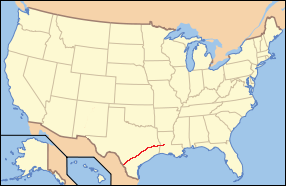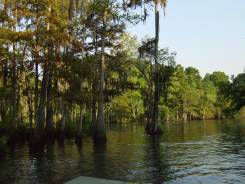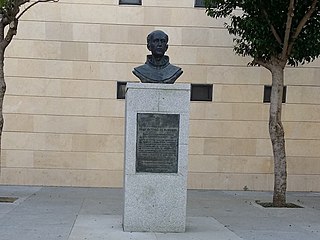
Los Adaes was the capital of Tejas on the northeastern frontier of New Spain from 1729 to 1770. It included a mission, San Miguel de Cuellar de los Adaes, and a presidio, Nuestra Señora del Pilar de Los Adaes. The name Adaes represents the indigenous Adai people, who were to be served by the mission.

Spanish Texas was one of the interior provinces of the colonial Viceroyalty of New Spain from 1690 until 1821. The term "interior provinces" first appeared in 1712, as an expression meaning "far away" provinces. It is only in 1776 that a legal jurisdiction called "Interior Provinces" is created.

The Spanish Missions in Texas comprise a series of religious outposts established by Spanish Catholic Dominicans, Jesuits, and Franciscans to spread the Catholic doctrine among area Native Americans, but with the added benefit of giving Spain a toehold in the frontier land. The missions introduced European livestock, fruits, vegetables, and industry into the Texas area. In addition to the presidio and pueblo (town), the misión was one of the three major agencies employed by the Spanish crown to extend its borders and consolidate its colonial territories. In all, twenty-six missions were maintained for different lengths of time within the future boundaries of the state of Texas.

Mission San Francisco de la Espada is a Roman Rite Catholic mission established in 1690 by Spain and relocated in 1731 to present-day San Antonio, Texas, in what was then known as northern New Spain. The mission was built in order to convert local Native Americans to Christianity and solidify Spanish territorial claims in the New World against encroachment from France. Today, the structure is one of four missions that comprise San Antonio Missions National Historical Park.
Domingo Terán de los Ríos served as the first governor of Texas from 1691 to 1692. He also governed Coahuila, in the modern-day Mexico.

Louis Antoine Juchereau de St. Denis was a French-Canadian soldier and explorer best known for his exploration and development of the Louisiana and Spanish Texas regions. He commanded a small garrison at Fort de la Boulaye on the lower Mississippi River, built in 1700, and founded Fort St Jean Baptiste de Natchitoches in northern La Louisiane, as they called the French colony.

The El Camino Real de los Tejas National Historic Trail is a national historic trail covering the U.S. section of El Camino Real de Los Tejas, a thoroughfare from the 18th-century Spanish colonial era in Spanish Texas, instrumental in the settlement, development, and history of Texas. The National Park Service designated El Camino Real de los Tejas National Historic Trail as a unit in the National Trails System in 2004.
José de Azlor y Virto de Vera, second Marquis of San Miguel de Aguayo by marriage, commonly known as the Marqués de Aguayo, was the governor of the provinces of Coahuila and of the New Philippines in New Spain between 1719 and 1722. During his tenure, Aguayo retook eastern Texas from New France without firing a shot. He established or reestablished seven missions and three presidios, and quadrupled the number of Spanish soldiers stationed in Texas. Aguayo and his wife were also owners of a very large estate, or latifundio, in Coahuila. His descendants inherited and expanded the landholdings. The Aguayo dynasty continued until 1825.

The New Philippines was the abbreviated name of a territory in New Spain. Its full name was Nuevo Reino de Filipinas.
Cayetano Pignatelli, 3rd Marquis of Rubí, 9th Baron of Llinars was a Spanish nobleman and military figure who played a very important role in determining Spanish policy towards Texas and Mexico. He abandoned the East Texas colonies in the 18th century.
Martín de Alarcón was the Governor of Coahuila and Spanish Texas from 1705 until 1708, and again from 1716 until 1719. He founded San Antonio, the first Spanish civilian settlement in Texas.
The Eyeish were a Native American tribe from present-day eastern Texas.

The Nacogdoche are a Native American tribe from eastern Texas.

Antonio de San Buenaventura y Olivares or simply Fray Antonio de Olivares was a Spanish Franciscan who officiated at the first Catholic Mass celebrated in Texas, and he was known for contributing to the founding of San Antonio and to the prior exploration of the area. He founded, among other missions, the Alamo Mission in San Antonio, the Presidio San Antonio de Bexar, and the Acequia Madre de Valero.
Isidro Félix de Espinosa (1679–1755) was a Franciscan missionary from New Spain who participated in several expeditionary missions throughout the province of Tejas. He was the president of the missionaries from the College of Santa Cruz de Querétaro.
Fernando Pérez de Almazán, was a Spanish emissary who served as the first governor of Texas as an politically independent province from Coahuila (1722–1727).

Presidio de Béxar was a Spanish fort built near the San Antonio River, located in what is now San Antonio, Texas, in the United States. It was designed for protection of the mission San Antonio de Valero and the Villa de Bejar. The Presidio de Bejar was founded on May 5, 1718 by Spanish colonial official Martin de Alarcon, and his party of thirty-five soldiers. The Villa de Bejar is known for being the first Spanish settlement of San Antonio and consisted of the families of the Presidio Soldiers and those of the prior expeditions. It also served to secure Spain's claim to the region against possible encroachment from other European powers.

Dón Antonio Gil Ybarbo (1729–1809), also known as Gil Ybarbo, Gil Ibarbo, and many other name variants, was a pioneering settler of Nacogdoches, Texas. Ambiguously described by the National Park Service as a "prolific trader and smuggler," Gil y'Barbo's contribution to Texas was essential to the well-being of "his people," and a critical element in providing a staging point for the Anglo-American settlers that would follow them.

Mission Dolores State Historic Site (41SA25) is a 36-acre historic site including a 9-acre (3.6 ha) archaeological site listed on the National Register of Historic Places in San Augustine County, Texas that preserves the location of a Franciscan mission originally established in 1721. The site is located on the original El Camino Real de los Tejas trail. The site has no above ground remains of the mission but the mission's location is confirmed through archeological excavations. It is located half a mile south of San Augustine in the Piney Woods region of east Texas. Operated by the Texas Historical Commission, the site includes a campground, museum, gift shop and hiking trails.
José Domingo Ramón was a Spanish military man and explorer who founded several missions and a presidio in East Texas to prevent French expansion in the area.












